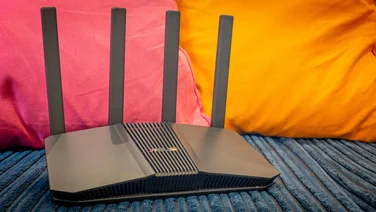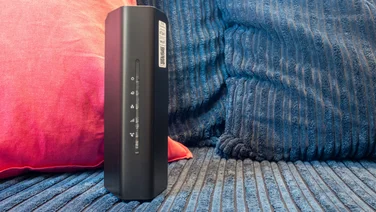To help us provide you with free impartial advice, we may earn a commission if you buy through links on our site. Learn more





- Easy to set up
- Wi-Fi 6 and powerline connectivity
- Good consistent speeds where building materials or distance inhibit Wi-Fi range
- Performance depends on your mains cabling
- Not as fast as a mesh system or Wi-Fi 6 router at short range
- Lacks the controls of more advanced mesh systems
You could argue that today’s mesh systems have stolen powerline networking’s thunder. Looking to cover the whole home in Wi-Fi? Even a cheap Wi-Fi 5 mesh might do the trick, or you might find a single Wi-Fi 6 router will have you covered for £100 or less.
Yet there are still situations where running home network data across your mains cable is a better option, giving you more bandwidth where you need it most. Maybe you have an awkwardly shaped home, long and thin, where you’ll struggle to get a good signal at range? Or you have to get a connection to a garage or outbuilding, through thick stone or concrete walls and a lot of glass? In these situations, powerline still rules, and by taking a hybrid approach you can still have the best of Wi-Fi, too.
Devolo Magic 2 WiFi 6 Whole Home Kit review: What do you get for the money?
This is exactly what Devolo has done with its Magic 2 WiFi 6 range. Each kit consists of an Ethernet-to-powerline adapter and one or more powerline-to-Ethernet and Wi-Fi 6 extenders. These effectively work like a mesh system using powerline as the backhaul with data rates running at up to 2,400Mbits/sec over your mains and 1,800Mbits/sec dual-band over Wi-Fi 6 in 2×2 MU MIMO configuration.
As you might expect, these figures are theoretical maximums – you won’t ever see the 1,201Mbits/sec you could potentially realise over the 5GHz band on Wi-Fi 6, let alone the 2,400Mbits/sec on Powerline – but you’ll still be looking at higher speeds than previous-generation devices, giving you faster Wi-Fi and better signal strength around your home.
Devolo launched the range with a two unit starter kit, including a wired LAN adapter and a single wireless extender, plus a two-unit kit with the LAN adapter plus two wireless extenders. To this it has recently added a Mesh Whole Home Wi-Fi kit, which swaps the wired-only adapter for a Wi-Fi enabled unit, so you can connect it to an existing modem or router and have Devolo’s system as the only Wi-FI system in your home. This makes a lot of sense if you’re upgrading an old 802.11ac router and you want Wi-Fi 6 throughout the house; however, it comes at a fair old cost: £450 if bought directly from Devolo.





Both the adapters and extenders are pretty bulky white plastic units and, while each has a mains power pass through, you still need to make sure that there’s space for them to fit physically into the mains socket. Check that you have a good four inches of clearance above your socket before you buy.
READ NEXT: The best mesh Wi-Fi extenders
Devolo Magic 2 WiFi 6 Whole Home Kit review: How easy is it to set up?
In theory, the units in each kit come pre-paired and work as soon as they’re plugged into the mains. This didn’t work out with our initial Whole Home review kit but worked flawlessly with the newer Mesh Whole Home Wi-Fi kit. In any case, if you have the adapter and one extender plugged into adjacent sockets, it only takes one button press on each to get them connected. If you’re happy to run with the default network name and password, that’s all it takes.





If not, you have a few options. Firstly, you can press the Wi-Fi button on a wireless unit then press the WPS button on your router, and it should clone the SSID and password from one to the other. If this doesn’t work, you can install Devolo’s Home Network app and change the SSID and password manually from there. Once you change it on one Wi-Fi unit, it seems to copy across to any others on your Powerline network.





Finally, you can use Devolo’s Cockpit app on your PC or laptop, or the browser-based UI. Both feel a little dated and aren’t particularly intuitive but it isn’t difficult to find the necessary settings and alter them. You can also check for firmware updates while you’re there.
The Cockpit app also comes in useful for positioning your extenders, as you get an at-a-glance display of your powerline network with the current connection speed between each extender and the main adapter clearly listed. On top of that, the browser-based UI also features simple parental controls, where you can define devices by their MAC address then set time periods during which Wi-Fi access is allowed. It’s basic stuff and the setup feels old-fashioned but it’s still good to have the option.
The Home Network app has the same line-up of features, plus tools to set up a guest network. You can also assign names to specific extenders, making it easier to track which one you’re checking and where it is in the home. All the same, I can’t help feeling that Devolo doesn’t give you the kind of control we’re seeing with the more established or advanced Mesh systems. There’s no easy way to get detailed information on which devices are connected to which extender, find out how much bandwidth they’re consuming or suspend their Wi-Fi access if they’re hogging too much. Additional security and privacy features are short on supply, and the same goes for parental controls.
Devolo Magic 2 WiFi 6 Whole Home Kit review: How well does it work?
Devolo’s kit is undeniably effective when it comes to getting Wi-Fi to the furthest corners of your home. At the moment, my normal network runs on a two-node Netgear Orbi dual-band Wi-Fi 6 AX1800 (RBK352) setup, with the main router in my living room and the second node in an upstairs office.
Testing with a NAS plugged into the router and a Lenovo ThinkBook laptop with a 2×2 Wi-Fi 6 network card, I can get a maximum 16.2MB/sec upstream and 12.9MB/sec downstream in the kitchen at the opposite end of the house. With the Devolo kit, those figures rise to 37.5MB/sec and 29.1MB/sec.





However, much depends on the quality and layout of your mains wiring. In the upstairs office, the Orbi gives me 32.2MB/sec and 21.2MB/sec. Even with some trial-and-error repositioning of the two extenders, the best I could get from the Devolo kit was 17.3MB/sec and 8.3MB/sec. These results aren’t disastrous – they still equate to 138Mbits/sec and 66Mbits/sec – but they’re a little disappointing given the headline speeds.
Similarly, speeds at close range are broadly similar to what you’d get from a stand-alone or Mesh Wi-Fi 6 router. With the Wi-Fi adaptor from the Devolo Mesh Wi-Fi Whole Home Kit plugged in instead of the main Orbi module and the test laptop 2m away, I recorded downstream speeds of 68MB/sec and upstream speeds of 63MB/sec. With the Orbi, these were 71MB/sec and 60MB/sec respectively. In the hallway next door the Orbi system gives me 46MB/sec downstream, compared to 45MB/sec from the Magic 2 WiFi 6, although this rose to 49.8MB/sec when the laptop was connected to the extender via Ethernet.
Other options may be faster. For instance, when I tested TP-Link’s AX90 router it gave me downstream speeds of 43.9MB/sec in the office and 54.6MB/sec in the kitchen; pretty good for a single unit costing under £250. With the addition of the TP-Link RE505x AX1500 range extender, I was able to get the office speeds up to 50.7MB/sec.
READ NEXT: The best Wi-Fi extenders to buy
Yet there are still areas where the Magic 2 WiFi 6 kit comes into its own. In my outside office, the highest downstream speed I’ve ever seen from a Wi-Fi extension kit is 4.2MB/sec. Even the fastest powerline setup I’ve tested only reached 11.2MB/sec. The Magic 2 WiFi 6 kit averaged out at 12.5MB/sec in testing, with peaks of over 16MB/sec.
And I’ll say one more thing for the Magic 2: it’s consistent. Having lived with three Wi-Fi only Mesh systems, speeds can vary. Interference, shut doors and a lot of traffic on the more distant units sometimes have a negative effect on bandwidth, in ways I can notice while, for instance, streaming or downloading games. In my experience, Devolo’s kit delivers the same bandwidth to the same places all the time, thanks to that Powerline backhaul, and switching from node to node is flawless. If I’m streaming games on Xbox Games Pass or Google Stadia, it’s no longer touch and go on whether it’s going to work in this specific room at this specific time. Of course, a more expensive, triple-band Wi-Fi-only Mesh kit would arguably solve most of these issues, but not when they’re inherent to the build and layout of the house.
Devolo Magic 2 WiFi 6 Whole Home Kit review: Should you buy one?
Maybe. In many UK homes you’re likely to get better performance and an easier-to-manage network from either a modern Wi-Fi 6 router or a good mesh system. What’s more, the prices of comparable Wi-Fi 6 mesh systems are now falling below £250.
All the same, there are situations, if you have a distant room or an outside office, where the Magic 2 WiFi 6’s killer combo of Wi-Fi 6 and powerline is going to give you better results, while still dishing out decent speeds throughout your home. Just be aware that much depends on the state of your mains cabling and how it’s been laid out.
In the right circumstances, Magic 2 WiFi 6 can stretch your Wi-Fi further than just about anything else, even if it isn’t the fastest or the cheapest option for the average-sized home. And with the new Mesh Wi-Fi Whole Home Kit, it’s not just an extension of your existing Wi-Fi, but a stand-alone solution to replace it. It’s not the right choice for every home, but for those with thick walls, long distances and awkward layouts, it might just be the most practical.






